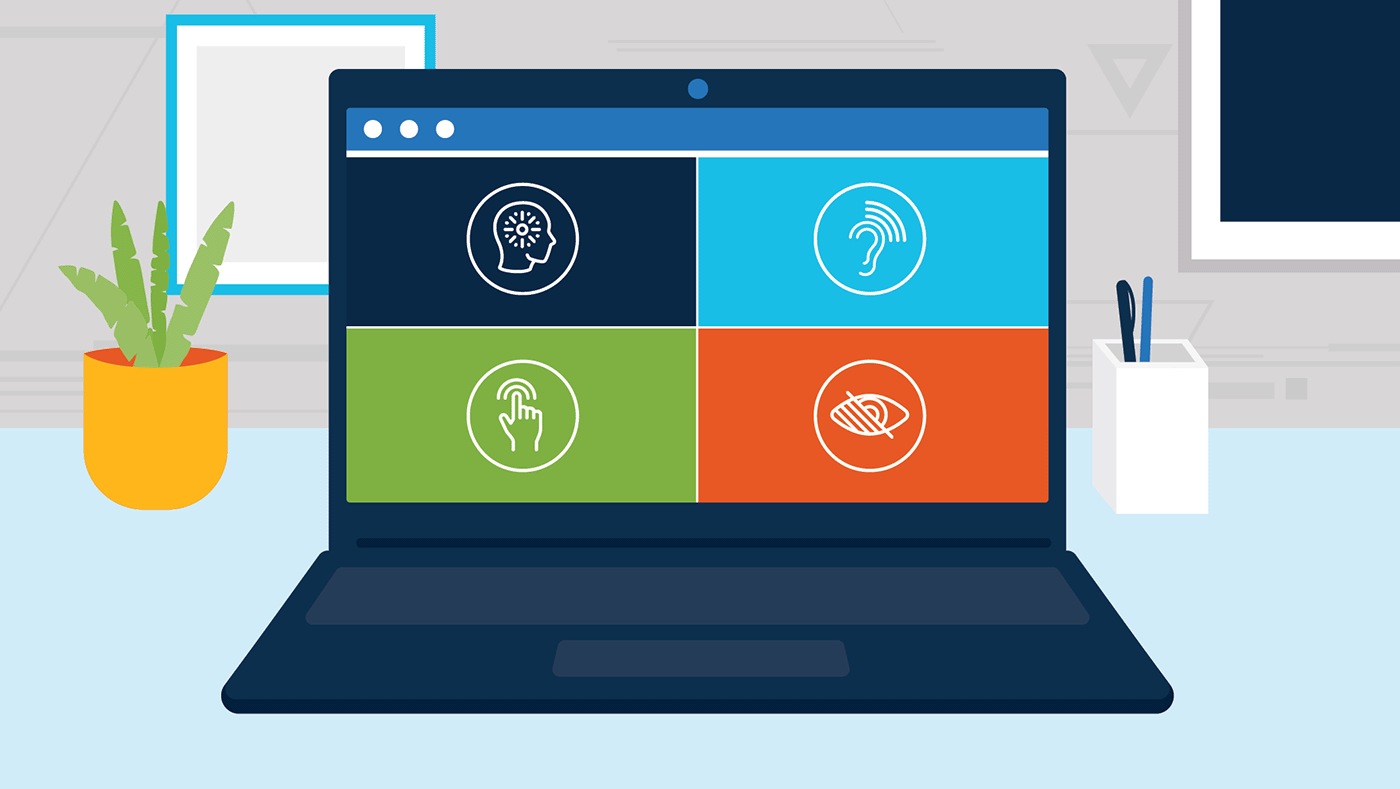Appears In
Did you know that approximately 300 billion emails are exchanged each day? The task of reading and composing emails can often feel like a never-ending part of our daily to-do list. What’s perhaps even worse is receiving email after email that contains a wall of text and an array of highlighted and bolded words, images, and graphs. Whether you use email for professional reasons, personal reasons, or both, so many of our daily correspondence is completed via email. However, for people with disabilities, such as those affected by a visual impairment, understanding the contents of an email can be a complicated process depending on the combination of text, images, links, and other assets.
Accessibly designed emails are important now more than ever before. Composing emails that are accessible to everyone means incorporating elements such as writing in plain language and using proper document structure, including embedded fields and meaningful links. The Department of Veterans Affairs (VA) Office of Information and Technology (OIT) prioritizes properly formatted emails as part of all electronic correspondence to ensure that Veterans, and their support network, as well as VA employees and industry stakeholders, have equitable access to important VA information.
Getting Started with Plain Language
Accessibility begins with creating products from a standpoint of technical compliance and inclusivity – from the words we use to the ways we arrange images, tables, and other graphics in the email. We may all be guilty of “going through the motions” when crafting an email, but there is an etiquette that is often overlooked, beginning with our verbiage choices. Plain language is arguably the most universally applicable way that an email can be understood by everyone. As outlined in the Plain Writing Act of 2010, plain language is the practice of writing in a manner that is clear, concise, and does not contain lots of acronyms or industry-specific technical jargon that may cause confusion outside of a specific field or audience. Hallmarks of correct plain language include using “you” and other pronouns, writing in active versus passive voice, incorporating short sentences and paragraphs, and integrating easy-to-follow design features such as lists, headers, and tables. For example, a sentence about new proposed regulations written in passive voice might read “New regulations were proposed.” Rephrased with active and engaging language, the phrase would read “We proposed new regulations.”
Additionally, plain language encompasses basic editing best practices, such as abstaining from using slashes like “and/or.” These standards are particularly important to adhere to when the same email content is distributed widely to a diverse audience of hundreds or thousands of recipients — like in an email blast or newsletter used to communicate to a large customer base. The correct use of plain language in these instances ensures that all recipients have equal opportunity to understand the message being conveyed in writing, such as for individuals with various reading cognition levels, or for those whom English is not their first language. While clear writing via plain language standards is one of the most universal best practices to safeguard the accessibility of emails for everyone, many other accessible design features are essential to ensure disabled individuals have equitable access to information received in emails.
Additional Best Practices for Email
Section 508 of the Rehabilitation Act of 1973 is a law that requires all Federal agencies to ensure that any technological platforms used for official government purposes can be interpreted by anyone to the extent that it does not cause an “undue burden” for any specific group of people. OIT goes a step further by educating the content creators — those individuals designing websites, sending emails, and creating PowerPoint presentations — about their role in integrating accessibility functions, including those applicable to composing emails, into their work products. Martha Wilkes, Designer and Accessibility Strategist in OIT’s Office of the Chief Technology Officer, and Pat Sheehan, Chief of VA’s Section 508 Program Office, both understand how properly formatted emails makes content accessible to disabled individuals, such as those affected by a visual impairment.
According to the World Bank, fifteen percent of the world’s population experiences some form of disability, meaning they are impacted by a physical disability, such as blindness or other form of visual impairment, or a cognitive disability. Furthermore, an estimated one million Veterans are affected by compromised visibility. Many individuals who have low or no vision must rely on a screen reader that converts visual information into an audio format. Document structure is also integral to the effectiveness of the screen reader to accurately interpret emails. Document structure is an embedded framework of organization within an email that provides a set of instructions for the screen reader to translate into an audio format. For example, Mr. Sheehan points out that if any embedded fields in an email — like those that read “sign here” — are not correctly embedded in the document structure, the screen reader’s “voice output voice input technology is…going to be lost and won’t effectively jump to [the next sentence,] if [the recipient has] to fill something out or manipulate something in that email.”
These nuances can be problematic when used in email blasts, which often use Customer Relationship Management (CRM) programs, such as Salesforce or HubSpot, that streamline the logistics of sending emails in bulk. Such programs can be inconsistent regarding how and if certain accessibility features are integrated into their platforms to accommodate for assets including blank text fields, images, and other graphics. These accessibility discrepancies may result in viewability problems, such as left to right scrolling issues, certain features that are lost when an email is viewed on a smart phone vs laptop, or inaccessible email attachments. Additionally, screen readers cannot read scanned image files, such as .tif or .jpg. OIT’s Email Product Guide outlines steps to take to ensure accessibility with attachments.
Similarly, meaningful links are another component of accessible design that can result in a discrepancy between the intended meaning in the email and what the screen reader interprets, especially when distributed in a mass email blast. Meaningful links refers to the use of descriptive and actionable language as part of the actual hyperlink, such as a hyperlink that reads “VA hospital locations in the U.S.,” rather than using a full URL or generic hyperlink descriptions such as “click here,” “learn more here,” or “find additional details here.”
Luckily, more and more email platforms are making accessibility easier to build into an email. Within the Microsoft Products Suite, Outlook’s Accessibility Checker identifies potential elements that a screen reader may be unable to interpret in an email. The Checker detects a variety of potential accessibility barriers, including the presence of alt text, tables, and graphs. To use the Accessibility Checker once your email is drafted and ready to send, select the “Accessibility Checker” button in the email ribbon. Any outstanding accessibility issues that need to be addressed will appear in a list on the right-hand side of the email window.
The benefits of accessible emails extend far beyond the disabled community. Ms. Wilkes attests, “We’ve had Veterans tell us that even though they’re not officially screen reader users due to a vision disability, they get migraines as a side effect of the traumatic brain injury that they sustained during military service. When they have a migraine, they will turn off the bright monitor and use the voiceover feature to let their computer read the email out loud. It’s another classic example of accessible technology that can be useful for everyone.” Composing accessibly designed emails and email blasts ultimately comes down to arranging the information in such a way that can be most easily understood by the largest number of people. From bank statement notices to bake sale announcements, we all deserve to have equitable access to the information contained in emails. OIT understands this and considers it an extension of the commitment to Veterans to ensure that all VA related email correspondences are accessible to everyone.
Accessibility at VA starts with you. To learn more about accessibility, explore OIT’s Accessibility Guide and watch OIT’s Accessibility videos.
Our commitment to digital and IT transformation is shaped by our daily dedication to customer service and the close collaboration of our workforce, managers, and leaders. Ready to join us in improving Veterans’ care? Check out all current information and technology career opportunities on DigitalVA. You can also contact VA’s Office of the Chief Human Capital Officer at 512-326-6600, Monday thru Friday, 7 a.m. to 5 p.m. CST or by submitting a resume to VACareers@va.gov.
Topics in this story
In this article






